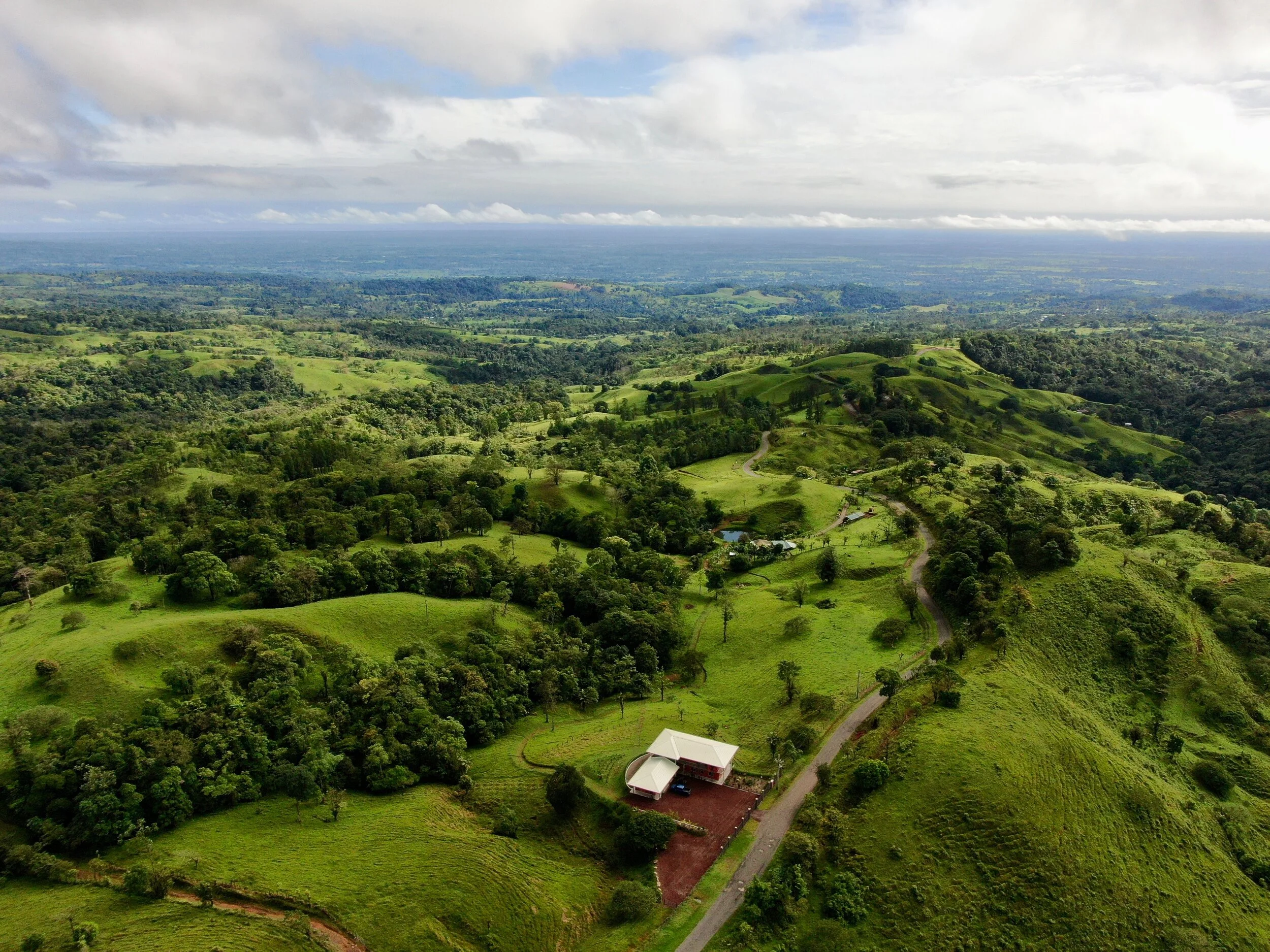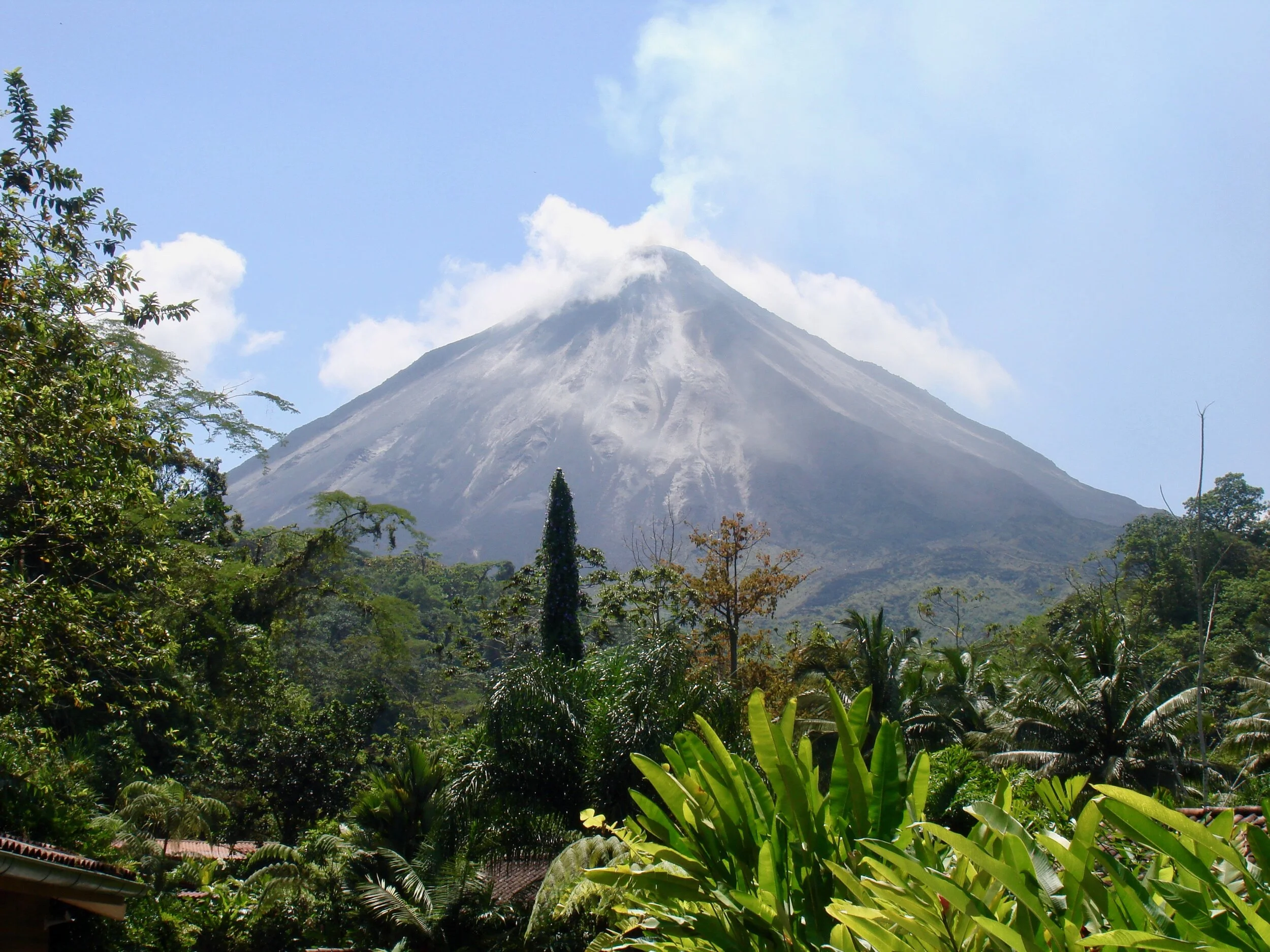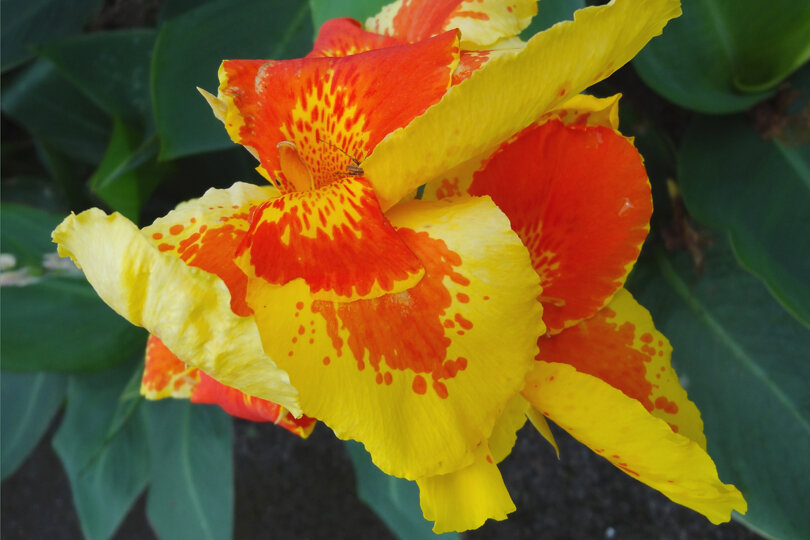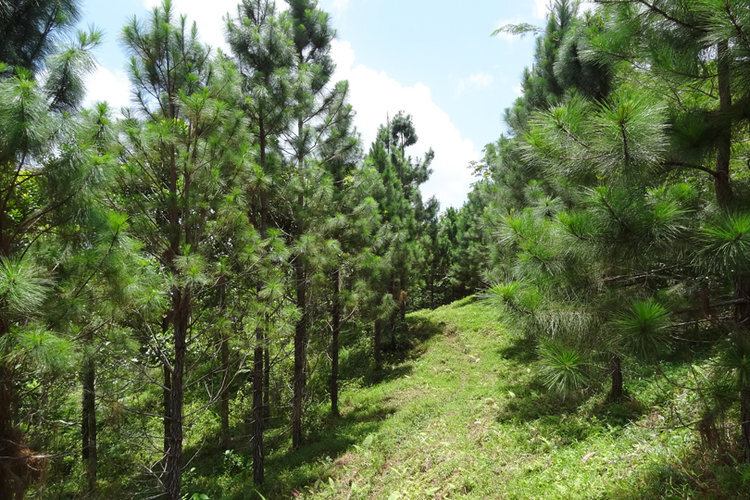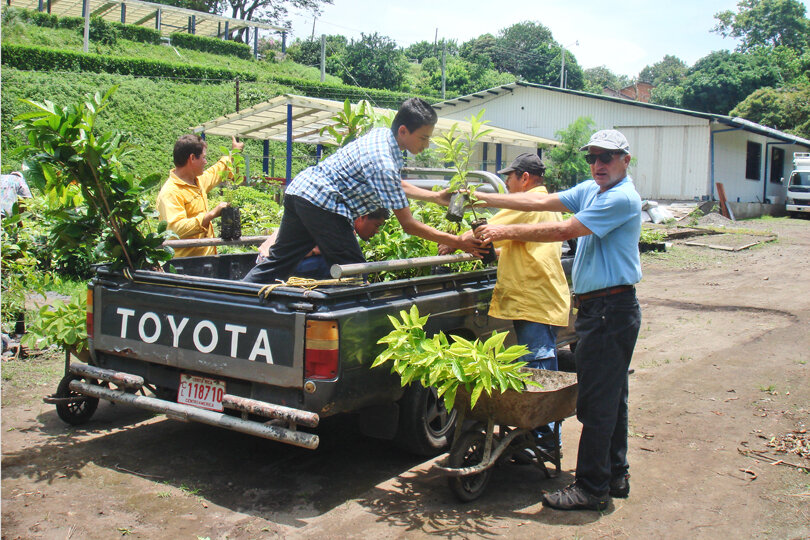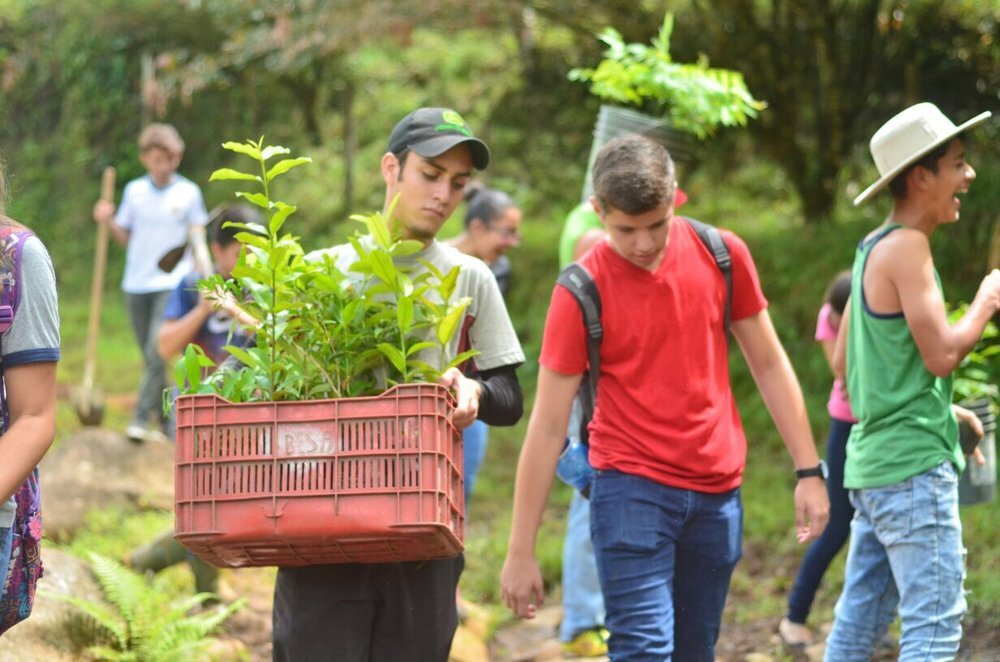You have to be on this road to believe it.
So Ehud, Mahar, and I were on this road, chugging along from the town of Arenal to the town of Guatuso.
On our left, beyond a stretch of grassy pastures, we saw a dense crown of lush, green vegetation, unbroken by human activity, extending far into the horizon.
“It is the Rio Coté National Forest,” Ehud said. At one time the forest had extended all the way to the road and beyond. That was before the forest was clear-cut to create land for grazing. Now, this rain forest is out over there, waiting patiently to be invited in to the pastures. I looked sideways and saw Ehud’s profile. It was clear to me that he was thinking. As his wife of many years, I can almost read his mind, and I knew the forest would be invited back in, sooner or later. It was just a matter of time. He will make sure that the forest has more room to wiggle its toes and spread its footprints so that the birds and the bees, the snakes and the frogs that Costa Rica is so proud of will have more room to live.
One thing led to another, and soon Ehud had the chance to purchase 300 acres of farmland. What was most attractive about this land was that on one side the entire property line was contiguous with the National Preserve of Rio Coté rain forest. In addition, a part of this land was still a primary jungle untouched by human hands, a rain forest so dense and difficult that no one would dare wander there on his or her own. “Let us invite the forest in,” were Ehud’s words, and with this simple motivation the Hacienda Rio Coté Reforestation Project was created in August 2007.
“Driving up at 20 miles an hour, on this calm stretch of dark gray river rocks strewn on a narrow path, with gently rolling hills and undulating land on either side, with hardly any traffic, you almost feel you are going far into eternity. You simply can’t rush. And that gives you time to see and feel.”
Aims of the project:
Preservation of primary forest.
Multi-use, socially responsible, and community oriented reforestation of clear-cut land.
Propagation of the native tree species of the rain forest by collection of seeds and saplings from the rain forest and
facilitating their growth in the “Primal Nursery” so that these saplings could be used in our reforestation projects.Carbon farming—grazing after the patterns of wild herds for soil sequestering of carbon.
The very first step in this direction was to speak with the locals and ask them how such a project would affect their lives.
We spoke to Jorge, our Tico friend who has two young children. He sees land as a source of income. His livelihood depends on the cows grazing on the land. But he is aware enough to understand the impact of deforestation on soil, water, and air quality. He would like his children to have the richness of the rain forest, because that is their heritage, but he would also like to see them have a sustained livelihood. “We could rotate the cattle between fields,” Jorge said. “This will give the soil time to recover and grow fresh grass. This will also restrict the cattle from eroding the fragile land and spoiling the water bodies. But definitely, extending the forest will help all of us in many ways.”
Soon Jorge, his three older brothers, and a few nephews were marking out areas where the cattle would be grazing, and Ehud was marking out where the forest would be invited in. At about the same time Codeforsa (an NGO that provides forestry engineers for reforestation) was contacted, and Oscar, who came to talk “forest” with Ehud, turned out to be a representative of one of the massive reforestation programs underway in Costa Rica.
The Codeforsa Nursery people were generous and hospitable and were very happy to take us around.
“We have 45,000 saplings, many of different species,” said the nursery manager proudly. He was also very knowledgeable about what tree species are native to the rain forest adjacent to our land, and he knew what would grow best there. As we toured his facility he told us many details about each tree species, about its growing conditions, fruits, flowers, wood quality, what birds and animals loved it, and whether the tree should be planted on slopes or near water bodies or away from wind, and so on. “We are expanding our list. Come again in December and we will have many more varieties for you,” he said. In the meantime more than 3,000 saplings were selected for our project. “Every year we will give you 3,000 more,” he said. “Don’t stop planting, ever.”
““My country is realizing that her real wealth is in her forests. We will do all we can to keep her forests healthy and growing.” ”
The saplings are loaded onto a truck in handmade boxes.
Another nursery staff member showed us how to space the saplings and prepare the soil for planting.
“You just need to give them a head start for the first two years. Soon they become taller than the grass. After that you just have the pleasure of watching them grow. You don’t have to do anything else.”
We were overjoyed by the sight and smell of all those thousands of healthy saplings, their tiny crowns swinging in the warm breeze, their young, soft-green leaves sparkling in the brilliant sunshine. Each sapling waiting patiently for its turn to be planted and the opportunity to become a mighty tree. We also were happy to see that Codeforsa was geared to sustain biodiversity and was not eager to make a fast buck by selling us the “hot tree of the month with the best timber value.” This nursery is funded by the Costa Rican government and operates on a small budget, but it is a very forward thinking project in our view.
We purchased another 1,000 saplings from La Reserva Nursery, a nursery devoted exclusively to reforestation. Now, we had 4,000 green babies to care for.
Back at the farm, Jorge rounded up a team of eight men from the tiny village of Cabanga. Vincent, the son of our neighboring farmer, Vin Palos, also came up “to help.” For Vincent and the other members of the team, “to help” is an understatement. “To help with a great attitude and happy smile” is a more accurate description.
Each day they arrived for “helping” riding their horses or catching a ride with one of the very few to be found vehicles on the road surfaced with river rocks. They would begin working all very cheerful, ready to take on a day of digging dirt, plopping a sapling, digging dirt, plopping yet another sapling. The hot sun brightened their days, the ever present breeze made the perpetual sweating tolerable, and even as the numerous ants and bugs feasted on their skin, the team remained so upbeat throughout that we could easily understand why Costa Ricans are in the habit of returning your greetings with “Pura vida” (the pure life).
The saplings are moved to the planting site by ox cart.
“We like what you are doing to the land,” one of the workers shyly spoke up for the team, though from how they worked, it was obvious to us that they loved what we were doing.
There was a simple economic reason as well. For Cabanga, which does not have a regular source of employment or income for people other than their farm and animals, this reforestation program gave several weeks of reliable work for these men. Their joy at receiving pay every Friday was hard to hide and hard to ignore.
On a typical day, the work team planted saplings from morning until about 2:00 PM. Then the workers begin winding down the day’s rhythm and heading home, just before the great mass of the dark, black clouds pregnant with water begin rolling up from the horizon. Soon hundreds of lightning bolts will ruthlessly slash the sky in pieces and zigzag their way to the earth in a blinding blaze of light followed by booming thunder so loud and so near that you cover your ears in a reflex action and close your eyes tight. If you were caught in the downpour, you would quickly run for the nearest shelter so your skin would not become black and blue from the rain to follow, pelting down so heavily that you would not be able to hear a word anyone spoke to you or be able to see beyond a few inches. Add the power of strong wind and in just a few minutes of exposure you would be drenched to your very bones.
Apparently, our dear saplings need this daily rain.
After getting drenched and quenched, they stand upright the next day, happily swaying in the gentle morning breeze. Were it not for this daily deluge of rain that we could depend upon, can you imagine watering all these saplings every day with a watering can or a hose, or installing any other irrigation system?
“You have picked a good time to plant, just after the dark moon, and right when the rainy season is on,” said the patriarch Vin Palos from atop his horse. He was on one of his inspection tours of the reforestation project, riding along the contours of the land on his gentle horse. He would often just casually come by to see about the progress of the work and offer tips as per need. All the men in the team respected the old man and his vast knowledge about the land and the trees.
In about four weeks all the saplings were planted, and the team moved on to other areas to prepare and mark the land for further planting, clean up after themselves, weed, maintain inspection trails, and locate and divert the colonies of leaf cutter ants.
We did not want these critters anywhere near our newly reforested sites, but it seems that they are regular inhabitants of the rain forest and help keep the forest from overgrowth and crowding. At first glance what they do to the trees (chopping up the leaves, carrying the pieces in a procession into their nest that rises a few feet above ground, and feeding these bits to the fungus that is their actual food) appears to be rather cruel. The leafless trees eventually die and fall down, but then they become natural compost and a habitat for many epiphytes and saprophytes, all within a matter of a few weeks—so fast is the tropical rainforest ecosystem in recycling its waste.
One particular weekend, we went over to see the newly planted saplings. Ehud and Mahar rode on their horses, but I decide to walk a marathon. The saplings looked vibrant, healthy, upright, and with new leaf buds beginning to appear.
Ehud, who had just lost his beloved father (to nothing more serious than plain old age; he had lived a great life for 87 years), was totally at home here among all this new life.
“ “Creation is the spiritual content of life. We have just facilitated this creation to unfold within our sight,” he said gazing adoringly at a tiny sapling that was standing tall and proud. “And think of all the diversity.””
Yes, we had brought in 56 different species of hardwood, fruit, flower, and timber trees native to the local rain forest that lay just beyond our farm.
We were counting on the birds and animals to bring in the other species as the result of their roaming the rain forest foraging for fruits and seeds and then dropping off the end product of their digestion somewhere on the land. Unhurt by the process of digestion, these seeds will germinate, and in due course a very interesting mix of vegetation could be growing, bringing forth a level diversity that is impossible for humans to achieve in their efforts at reforestation.
Ehud continued to confide his thoughts to me: “In this biodiversity, the spirit of original creation resides. It is through the vibrant exchange of differences that the creation upholds. Whether in tiny, intracellular mitochondria or in the morphogenic field.”
I felt very privileged to hear Ehud speak thus. He had been so busy working with his team that he barely spoke, and I had almost forgotten that he was a book publisher first and last. For days on end he had left early in the morning, mingled with his team, dabbled in Spanglish, and dug the earth and planted the saplings. In the evenings, just before those famous downpours, he would come home, his clothing, hands, and face caked with clay, his shirt—damp with sweat—clinging to his body, his skin sporting a deep rich tan, competing with my own very brown color that I got from the continuous baking of all my ancestors and myself in the ever-present sunshine in India, the country of my birth. In the evenings Mahar would nurse his Papa’s many bites, stings, cuts, and bruises from working in the fields. In this process, Mahar almost memorized the inventory of an entire first-aid kit and taught himself all about various bandages—their size and application details—and learned about the healing properties of many lotions and creams.
Watching Ehud in such focused and deep contact with soil and with plant life, we saw firsthand that working with hands in the dirt and dealing with plants is deeply meditative, calming, and healing—a spiritual exercise for the entire being that was not lost on Mahar and myself.
After all, what are we but for our connection to the soil? We stand on it. We live off the bounty from its dirt, drink the water from deep in its womb, and when we move on—leaving our body behind—our body is invariably absorbed back into the soil. It is clear why Vedic seers and wise men and women from all ancient cultures around the world have called the earth—her soil, water, air, animals, and vegetation included—“The Mother.”
As the time for our departure back to the United States was coming near, our work crew began preparing several other sites for reforestation for when we would next return to Costa Rica. They also began offering ideas about orchards, about other tree species that they knew of, and most important, about yet another farm nearby that we could reforest. They were now completely into reforestation. It had now become their project, their pride, and their work. “We will work with you again anytime,” said the crew as we parted company. “We will have our orchards back.”
Some of them remembered their indigenous past clearly and recalled that before there was clear-cutting and monoculture the rain forest could offer them all that they needed—fruits and nuts from the many trees, small animals that they could trap, and fish they could catch for their food. They had grown up without packaged food from supermarkets and without the perils of industrial agriculture and grazing. They had lived in peace and harmony with the rain forest.
Yes, indeed. Reforestation can go on and on—in many ways it might not seem evident at first glance: it can help the local population prosper, provide ways and means for harvesting wood without clear-cutting the forest, teach young children about the trees and the bees and the cycle of life, give employment to members of the community, give a home to the flora and fauna of the rain forest, and help us feel a deeply committed and spiritual relationship with the earth and with her beautiful children—the trees and the animals.
And so goes the story of inviting the rain forest to extend its footprint. We can almost see the saplings growing right before our eyes. The slow ones grow a meter per year, the fast ones an astonishing four meters in the same time.
Nestled in the serene lap of the dormant volcano Tenorio, Rio Coté River, and National Rain Forest Preserve, with Lake Coté on one side and the great Lake Nicaragua on the other, our farm has been opened up to receive the rain forest. With our Tico friends we have humbly asked the trees to come and live and grow so that with each tree the rain forest will grow, too—and nurture the tiny speck of humanity that lives nearby.
All photos provided by Ehud Sperling unless otherwise noted.

